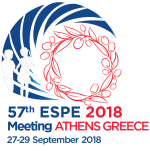
57th Annual ESPE
Athens,
Greece
27 Sep 2018 - 29 Sep 2018

Poster Presentations
Growth & Syndromes P3
hrp0089p3-p219 | Growth & Syndromes P3 | ESPE2018
Is Growth Hormone Deficiency a Contributor to Short Stature in Cutis Laxa Syndrome?
Albu Alice , Nicolaescu Irina Delia , Dinca Denisa
hrp0089p3-p220 | Growth & Syndromes P3 | ESPE2018
Effect of Sickle Cell Disease on Growth and Puberty
Omar Anjumanara , Abdallah Fatma , Mutai Beatrice
hrp0089p3-p221 | Growth & Syndromes P3 | ESPE2018
Two Siblings with Alström Syndrome
Cebeci Ayse Nurcan , Yesil Gozde , Ekici Baris
hrp0089p3-p222 | Growth & Syndromes P3 | ESPE2018
Development of an Online Learn-pro Module to Support Health Care Professionals Knowledge about Growth and Puberty
Wardhaugh Barbara , Shaikh Mohamad Guftat , Schulga John
hrp0089p3-p223 | Growth & Syndromes P3 | ESPE2018
Coeliac Disease in Turner Syndrome More Frequent Than Expected
Ouidad Baz , Mourad Semrouni , Samia Sakher , Zerguini Safia Mimouni
hrp0089p3-p224 | Growth & Syndromes P3 | ESPE2018
A 14-Year-Old Boy with Simpson-Golabi-Behmel Syndrome – Case Report
Sawicka Beata , Jakubiuk-Tomaszuk Anna , Borysewicz- Sańczyk Hanna , Michalak Justyna , Bossowski Artur
hrp0089p3-p225 | Growth & Syndromes P3 | ESPE2018
Central Precocious Puberty in a Girl with Silver Russell Syndrome
Wikiera Beata , Nocon-Bohusz Julita , Noczynska Anna
hrp0089p3-p226 | Growth & Syndromes P3 | ESPE2018
Etiologies of Short Stature in Pedaitric Endocrine Clinic in Northwest Region (Trakya) of Turkey
Ozkaya Beyhan , Dilek Emine , Bezen Diğdem , Ozguc Comlek Fatma , Tutunculer Filiz
hrp0089p3-p227 | Growth & Syndromes P3 | ESPE2018
Auditing Presentation, Investigations and Management of Turner’s Syndrome
Gunasekara Buddhi , Premathilaka Dilusha , Hasheem Raihana , Kollurage Udeni , Suntharesan Janani , Jeyanthakumar Rasarathinum , Armugam Puvana , Atapattu Navoda
hrp0089p3-p228 | Growth & Syndromes P3 | ESPE2018
Children Born Small for Gestational Age: Catch-up Growth During the First Four Years of Life
Freijo Martin Concepcion , Bertholt Zuber Laura , Palenzuela Revuelta Inmaculada
hrp0089p3-p229 | Growth & Syndromes P3 | ESPE2018
A Novel Heterozygous Pathogenic Variant in PORCN Gene Causing Focal Dermal Hypoplasia with Short Stature: Case Report and Literature Review
Wu Di , Hu Xuyun , Li Xiaoqiao , Wei Liya , Su Chang , Chen Jiajia , Qin Miao , Gong Chunxiu , Shen Yiping
hrp0089p3-p230 | Growth & Syndromes P3 | ESPE2018
Endocrinological Evaluation of Girls with Turner Syndrome Attending Alexandria University Children’s Hospital
hrp0089p3-p231 | Growth & Syndromes P3 | ESPE2018
A Long Follow-up in a Young Patient with Atypical Progeroid Syndrome
Scarano Emanuela , Tamburrino Federica , Lattanzi Giovanna , Perri Annamaria , Elena Presicce Maria , Mazzanti Laura
hrp0089p3-p232 | Growth & Syndromes P3 | ESPE2018
GH Treatment in Kabuki Syndrome: A Case Report
Guidoni Elisa , Lotti Federica , Geronzi Ursula , Arianna Sorrentino Laura , Grosso Salvatore , Municchi Giovanna
hrp0089p3-p233 | Growth & Syndromes P3 | ESPE2018
GH Treatment in Oto-Spondylo-Megaepiphyseal Dysplasia: A Case Report
Guidoni Elisa , Geronzi Ursula , Lotti Federica , Sorrentino Laura Arianna , Grosso Salvatore , Municchi Giovanna
hrp0089p3-p234 | Growth & Syndromes P3 | ESPE2018
Hepatic Glycogen Synthasedeficiency Associated with Growth Hormone Deficiency: A Case Report
Doneray Hakan , Ozden Ayse , Tosun Ilker
hrp0089p3-p235 | Growth & Syndromes P3 | ESPE2018
Analysis of Genetic Mutations in a Chinese Patient Affected with Noonan Syndrome
hrp0089p3-p236 | Growth & Syndromes P3 | ESPE2018
A Novel Homozygous Mutation in ERCC8 Cause Cockayne Syndrome a in a Chinese Family
Yang Yu , Huang Hui , Zhou Bin
hrp0089p3-p237 | Growth & Syndromes P3 | ESPE2018
Growth Hormon Deficiency in Identical Twins with Gitelman Syndrome due to Compound Heterozygous Mutation (p.R80fs*35/p.K957X) of the SLC12A3 Gene and the Evaluation of the Response to Growth Hormone Replacement Therapy
Yaman Betul , Celegen Kubra , Korkmaz Emine , Lafci Naz Guleray , Balik Zeynep , Demirbilek Huseyin , Duzova Ali
hrp0089p3-p238 | Growth & Syndromes P3 | ESPE2018
Hypothyroidism and Growth Hormone (GH) Deficiency, a Spotlight on De Novo Chromosomal 20p11.2 Deletion
Mohammed Idris , Al-Khawaga Sara , Hannah Reem , Saraswathi Saras , Haris Basma , Saeed Amira , Shararri Sanaa , Hussain* Khalid
hrp0089p3-p239 | Growth & Syndromes P3 | ESPE2018
Pharmacoeconomic and Adherence Analysis in Growth Hormone According to Galenic Presentation: In Vivo Study vs In Vitro
Diez-Lopez Ignacio , Sarasua Ainhoa , Lorente Isabel , Minguez Ana Cristinaa , Martinez Carlos
hrp0089p3-p240 | Growth & Syndromes P3 | ESPE2018
The Expression of Cytokines in SGA Children Throughout Lactation Allows to Characterize Early the Type of Cath-up
Diez-Lopez Ignacio , Sarasua Ainhoa , delHoyo Marta , Lorente Isabel , Segura Raquel Gomez de , Picon Minerva , Leniz Asier , Fernandez Alfredo , Puy-Portillo Maria
hrp0089p3-p241 | Growth & Syndromes P3 | ESPE2018
Small Stature: A Singular Difference for Accessing to Job
Diez-Lopez Ignacio , Sarasua Ainhoa , Lorente Isabel , Carranza Manuel
hrp0089p3-p242 | Growth & Syndromes P3 | ESPE2018
A Case of Hutchinson-Gilford Progeria Syndrome (HGPS) due to a Pathogenic LMNA Variant c.433G>A (p.Glu145Lys): Growth Hormone Administration Failed to Improve Growth and Long-term Outcome
Toni Ledjona , Dušatkoa Petra , Novotna Dana , Zemkova Dana , PrUhova Štěpanka , Lebl Jan
hrp0089p3-p243 | Growth & Syndromes P3 | ESPE2018
Increased Serum Activity of Liver Aminotransferases in Young Patients with Turner Syndrome
Wojcik Malgorzata , Ruszala Anna , Janus Dominika , Sztefko Krystyna , Starzyk Jerzy B.
hrp0089p3-p244 | Growth & Syndromes P3 | ESPE2018
Terner Syndrome: Epidemiological Study in Uzbekistan
Mirkhaydarova Malika , Ibragimova Nilufar
hrp0089p3-p245 | Growth & Syndromes P3 | ESPE2018
Shox Haploinsufficiency in Short and Not Short Children: A Sigle Italian Cetre Data
Maggio Maria Cristina , Ragusa Saveria Sabrina , Miceli Roberto , Corsello Giovanni
hrp0089p3-p246 | Growth & Syndromes P3 | ESPE2018
Microduplication of 3p25.3 and 4p23 Regions in a Patient with Multiple Congenital Anomalies, Congenital Hypothyroidism and Adrenogenital Syndrome
Barreca Massimo , Scavone Maria , Giancotti Laura , Colao Emma , Miniero Roberto
hrp0089p3-p247 | Growth & Syndromes P3 | ESPE2018
A Rare Chromosomal Disorder, Trisomy 4p
Hepokur Merve Nur , Tatlı Zeynep Uzan , Direk Gul , Akın Leyla , Hatipoğlu Nihal , Kendirci Mustafa , Kurtoğlu Selim
hrp0089p3-p248 | Growth & Syndromes P3 | ESPE2018
Prediction of Response to Growth Hormone Treatment in Korean Girls with Turner Syndrome
Jung Mo Kyung , Kim Se Young , Lee Ji-Eun , Kim Hae Soon , Yu Jeesuk , Yoo Eun-Gyong
hrp0089p3-p249 | Growth & Syndromes P3 | ESPE2018
A Rare Case of Turner Syndrome with the Presence of the Y Chromosome Genetic Material
Peskavaya Nadzeya , Solntsava Anzhalika , Shlimakova Katsyaryna
hrp0089p3-p250 | Growth & Syndromes P3 | ESPE2018
Prader-Willi Patient with Rectal Bleeding – Experience in Center for Rare Endocrine Disordesrs in Varna, Bulagria
Yordanova Nikolinka , Iotova Violeta , Galcheva Sonya , Bazdarska Yuliya , Mladenov Vilhelm , Boyadzhiev Veselin
hrp0089p3-p251 | Growth & Syndromes P3 | ESPE2018
Mosaicism 47XXX/45X0, a Case Report
Pinto Renata Machado , Duarte Sabrina Sara Moreira , Cunha Damiana Miriam da Cruz e , Ribeiro Cristiano Luiz , Silva Claudio Carlos da , Cruz Aparecido Divino da , Cruz Alex Silva da
hrp0089p3-p252 | Growth & Syndromes P3 | ESPE2018
Factors Influencing the Selection of Injection Areas During Self-therapy for Growth Hormone Therapy Among Patients 10–15 Years Old
hrp0089p3-p253 | Growth & Syndromes P3 | ESPE2018
Tall Stature: A Diagnosis is Sometimes Difficult
Kherra Sakina , Bekakcha Hadjira , Boutaba Mounia , Talbi Fatiha , Behidj Yasmina , Zeroual Zoulikha
hrp0089p3-p254 | Growth & Syndromes P3 | ESPE2018
Woodhouse-Sakati Syndrome: Clinical and Molecular Study on a Qatari Family with C2orf37 Gene Mutation
Al-Khawaga Sara , Khalifa Amal , Hussain Khalid
hrp0089p3-p255 | Growth & Syndromes P3 | ESPE2018
Factors Affecting Height Velocity in Normal Prepubertal Children
Kim Seul Ki , Choi Yujung , Lee Seonhwa , Lee Jun Hui , Ahn Moon Bae , Kim Shin Hee , Cho Won Kyung , Cho Kyung Soon , Jung Min Ho , Suh Byung Kyu
hrp0089p3-p256 | Growth & Syndromes P3 | ESPE2018
Low Dose Growth Hormone using IGF1 Dose Titration is Associated with Sustained Optimal Growth in a Child with Both Turner and Down Syndrome
hrp0089p3-p257 | Growth & Syndromes P3 | ESPE2018
Growth Response in Noonan Syndrome in Indian Children
Ramachandran Smita , Sethi Aashish , Kochar Inderpal
hrp0089p3-p258 | Growth & Syndromes P3 | ESPE2018
Late Referral of Siblings with Combined Pituitary Hormone Deficiency (PROP1)
Hasanbegovic Snijezana , Kljucic Amila
hrp0089p3-p259 | Growth & Syndromes P3 | ESPE2018
17p13.1 Microduplication Syndrome in a Child with Familial Short Stature and GH Deficiency: A Short Case Report
Leka-Emiri Sofia , Petrou Vassilios , Manolakos Emmanouil , Fotinou Aspasia , Thomaidis Loretta , Vlachopapadopoulou Elpis , Michalacos Stefanos
hrp0089p3-p260 | Growth & Syndromes P3 | ESPE2018
Prader Willi Syndrome: Clinical Profile
Chugh Vasundhara , Arya Archana Dayal
hrp0089p3-p261 | Growth & Syndromes P3 | ESPE2018
Leri-Weill Syndrome Phenotype with Atypical Cytogenetic Finding
Mladenov Vilhelm , Iotova Violeta , Angelova Lydmila , Stoyanova Milena , Bogdanova Viktoria
hrp0089p3-p262 | Growth & Syndromes P3 | ESPE2018
Deletion of 12q12 Increases the Risk of Growth Retardation and Intellectual Disability
Weng Ying , Luo Xiaoping , Hou Ling
hrp0089p3-p263 | Growth & Syndromes P3 | ESPE2018
A Patient with Turner Syndrome (45X/46XX) and Congenital Adrenal Hyperplasia
Wang Yirou , Ding Yu , Chang Guoying , Chen Yao , Shen Yiping , Wang Xiumin , Wang Jian
hrp0089p3-p264 | Growth & Syndromes P3 | ESPE2018
Congenital Tufting Enteropathy Caused by Mutation of EPCAM Gene: A Case Report and Review of Literature
hrp0089p3-p401 | Growth & Syndromes P3 | ESPE2018
Is Using a Specific Growth Charts a Chance to be More Precise in Evaluation the Growth of the Children and Adolescence with Down Syndrome? Comparison of the Down’s Syndrome Growth Charts with the Growth Charts for Polish Population
hrp0089p3-p406 | Growth & Syndromes P3 | ESPE2018
Two Siblings with Prader-Willi Syndrome Caused by Microdeletion Derived from the Paternal Grandmother
Dong Guanping , Dai Yangli , Huang Ke , Zou Chaochun , Chen Xuefeng
hrp0089p3-p412 | Growth & Syndromes P3 | ESPE2018
Novel Mutation of CHD7 in a Chinese Boy with Kallmann Syndrome
hrp0089p3-p413 | Growth & Syndromes P3 | ESPE2018
Conversion of Hypothyroidism to Hyperthyroidism in Children
hrp0089p3-p415 | Growth & Syndromes P3 | ESPE2018



